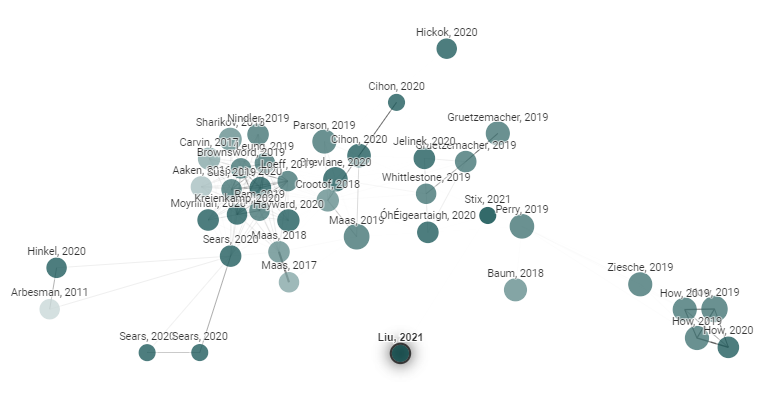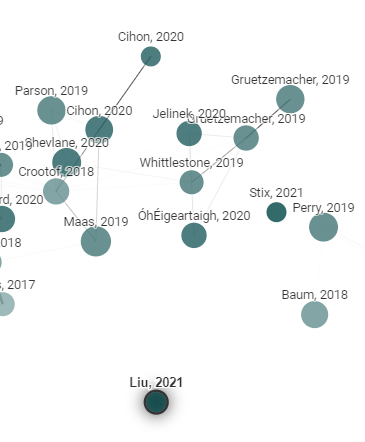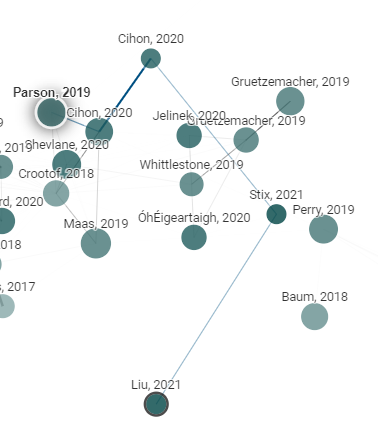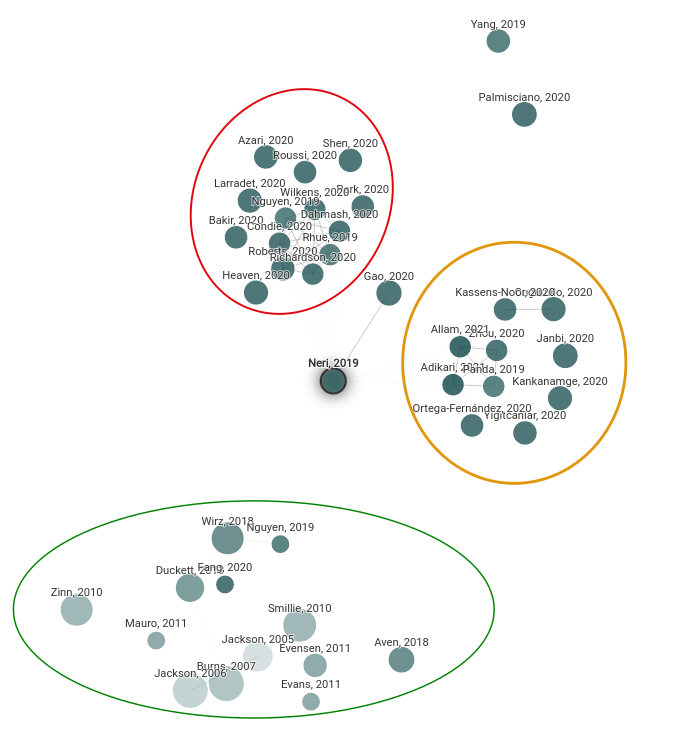Authors: Maris Sala, Carel Kuusk, Andres Tiko
[This blog post is the result of our team’s work during the Existential Hackathon event made by EA Estonia, 30th April until 2nd May, 2021]
Connected Papers is a tool developed and released in June 2020 by Alex Tarnavsky Eitan, Eddie Smolyansky, Itay Knaan Harpaz and Sahar Perets to get a quick visual overview of an academic field. It has been announced on LessWrong and mentioned on EA Forum previously but there hasn’t been much talk about whether this is specifically useful in the EA context. We bring you three case studies of selected existential risk papers by EA-aligned researchers, and show you how you could utilize this tool for
a) finding researchers relevant to your field (especially for literature reviews);
b) getting into a field of research;
c) discovering similar papers in adjacent fields.
We think this tool would be especially useful in finding EA-adjacent research and researchers.
In all the following figures every node corresponds to a specific article, node sizes correspond to the number of citations, the colors to the publishing year and the edge sizes and clustering correspond to the similarity of the articles. The sizes and colors are relative to the range of publishing years and number of citations that are present in any given graph. To find out more, read their Medium post of announcing the release.
Case study 1. Finding relevant researchers adjacent to EA
This case study was conducted with the article: “‘Solving for X?’ Towards a problem-finding framework to ground long-term governance strategies for artificial intelligence”. Authors are Hin-Yan Liu who seems to publish about EA topics but isn’t directly linked to EA. The second author is Matthijs M. Maas who is associated with CSER, CGAI, FHI, GCRI, NewForesight, and is a member of the EA Denmark Facebook group and can thus be classified as probably an EA.

Figure 1. Screenshot from Connected Papers showing the graph for the article by Liu & Maas.
This is the network Connected Papers created around this paper - they are marked as Liu, 2021 in the bottom of the graph (Figure 1). The paper is new and not well connected with the rest of the network - it connects directly via three connections which are visible when one uses the interactivity features of Connected Papers - hovering over a paper with your mouse allows the visualization of the shortest path between the original article and the reference (Figure 2).
A

B

Figure 2. Screenshots from Connected Papers to show the shortest path visualization. A - No connection visible between Liu, 2021 (bottom) and Parson, 2019 (top left). B - After clicking on Parson, 2019 it brings out the path between this article and the original Liu, 2021. The path from Parson, 2019 to Liu, 2021 includes Cihon, 2020 → Cihon, 2020 → Stix, 2020.
We extracted all authors of all the papers and checked their relation to Effective Altruism with a simple Google query consisting of their full name and the words “effective altruism”. Based on the first page results we tried to distinguish how aligned the authors are with EA.
All of the authors of the direct connections are represented in EA. Following the Perry, 2019 connection (bottom right cluster) we reach researchers who are referenced in EA topics but who do not seem to be part of the movement though their research seems relevant for the original paper (AI methods, pedagogy, human-centric AI approach to malnutrition).
The Stix, 2021 connection (upper side of the graph) leads to a cluster of researchers who all seem to be part of EA or where at least one author is clearly part of EA. This is useful for when a researcher wants to check how similar their research is to other EAs work and whether there are useful connections they could make with EAs who study similar things to them.
Lastly, the Sears, 2020 connection (left side of the graph and the tight cluster on the left) includes many articles from authors who do not seem to be directly connected to EA, but are doing EA and topic-relevant research. Here’s an option for finding collaborators from outside of EA, but also finding out how EA-relevant research topics are discussed outside of strict EA contexts.
Case study 2. Finding relevant fields adjacent to EA
Suppose you want to read a random paper pointed out in a forum / blog post somewhere or referenced to by a friend (whether EA-related or not). However, if the paper is outside your field of expertise, it is hard to place them into context, grasp the broader field and understand, which of the questions raised while reading the article have already been answered or investigated in other relevant research. For that purpose, Connected Papers suits quite well.
The article this case study is focused on is "The role of experts in the public perception of risk of artificial intelligence", authored by Hugo Neri and Fabio Cozman. In this work they analyzed how the experts and hypotheticals are influencing the AI risk perception (as opposed to events, such as self-driving car crashes). This is the output graph of the Connected Papers visualizer.

Figure 3. Screenshot from Connected Papers showing the graph for the article by Neri and Cozman.
Based on the Connected Papers graph, three similar clusters can be identified.
- Yellow cluster is a set of articles about urban planning, smart cities and catastrophe preparation.
- Red cluster contains articles analyzing more sinister AI applications, such as China’s approach and AI in workspace etc.
- Green cluster is a loose collection of research on risk perception and social amplification.
- The three remaining articles were research about perceptions and attitudes towards medical AI.
There are some other quick things we can see from the graph. For example, the red and yellow clusters are relatively new, written in 2019-2020, while the articles in the green cluster are about a decade old on average.
As none of us are active in the field of (existential) risk research and lack a direct connection to sociology or risk analysis, the graph-based visualization helps to grasp the structure of unknown fields. Of course, this example was cherry-picked exactly because of clear clustering of relatively unrelated fields, but based on our experiments these kinds of clustering patterns tend to pop up regularly.
Case study 3. Finding papers relating to subject matter from different scientific disciplines
The article under investigation is „Space Colonization and Existential Risk” by Joseph Gottlieb (2019, Journal of the American Philosophical Association). The paper is written as a reply to Ian Stoner’s 2017 paper „Humans Should not Colonize Mars”. The paper was picked from the results after searching for „existential risk” from https://philpapers.org.
The clustering produced by connected papers can be seen here. There are 26 references in the paper and 41 papers in the graph, but it is interesting to note that almost none of the references are represented in the Connected Papers graph. That also applies to Stoner’s paper - even though it can be considered as the originating paper, it is not represented in the graph. This shows that direct references do not play a big role in constructing the graph, but also that this approach can miss some clearly important connections.
The graph of related papers is mainly organized to two big clusters, which could be named as the „ethics cluster” and the „practical cluster.” The clustering seems to work well to group articles on related topics.
The ethics cluster consists of papers on topics related to ethics of colonizing other planets. Example titles include: „Ethics for an uninhabited planet”, „Can Deep Altruism Sustain Space Settlement”, „Self-preservation should be humankind’s first ethical priority and therefore rapid space settlement is necessary” and „Should and could humans go to Mars? Yes, but not now and not in the near future” .

Figure 4. Screenshot from Connected Papers showing the graph for the article by Joseph and Gottlieb.
The practical cluster contains mainly papers discussing practical questions related to human colonization of Mars and beyond, e.g. „The Martian: Possible Scenarios for a Future Human Society on Mars”, „Flashline Mars Arctic Research Station (FMARS) 2009 Crew Perspectives”, „Mars and Beyond: The Feasibility of Living in the Solar System”, „Martian Environmental Psychology: The Choice Architecture of a Mars Mission and Colony” and „Can Astronauts Survive Radiation on Prolonged Space Missions?”. This cluster also contains some articles that are not as closely related to the group as others. For example, the paper „From systems ergonomics to global ergonomics : the world as a socio-ecological-technical system” seems related if you look at the word use, but it looks like the algorithm is fooled by words like „ergonomics” and „space”, which are used in a totally different context in this paper. On the other hand, „Thematic issue: ergonomics in extreme environments and non-traditional workplaces” is very relevant to humans trying to live on Mars.
There are two papers which at first seem unrelated to the cluster: „The visual pleasantness in yacht design: natural lighting, views and interior colours” and „Design for human diversity in the maritime design domain”. But if you think about it, the maritime environment is in a way very similar to outer space and insights from that domain could be very relevant to space. So it is here that the connected papers algorithm could bring the most value - information that a person searching in a specific domain would probably never find, but which brings insights and helps to bridge the gap between different disciplines.
Summary
Connected Papers has many more features that we did not explore here. They have a list view for a quick at-a-glance overview of all the papers in the graph, prior and derivative works to see, which are the articles cited by the papers in the graph and which cite the ones in the graph. The tool is also connected directly via Arxiv under the ‘Related Papers’ tab, so you can get directly to the network from an article on their website
It is a powerful tool for not only finding articles’ citation networks, but also finding articles that are similar to each other. It’s easily accessible and is continuously updated with the newest research. If you find the papers represented in the graph useful, you can even download them and add them to your bibliography! Other people have also reviewed the usefulness of this tool.
In this article we highlight some of the properties that could help increase the awareness of whom to connect with in scientific disciplines in EA related fields - especially among fields that tend to be less researched from the EA perspective. We’ve also shown that this tool both helps to find very similar articles to the original, but in the further parts from the central article, it’s possible to find other perspectives and adjacent topic areas to the original article’s contents.
We hope you find this review helpful and happy connecting!
Hi, Connected Papers founder here. This is really awesome! It's wonderful to see the tool we developed being used for a cause so dear to our hearts.
We've retweeted your work on our channel to give it (and Effective Altruism in general) more exposure. We'll possibly add it to our newsletter as well.
Thank you for sharing and keep up the exploration!
Strong upvoted, I made a graph with it for a paper I intend to use for my summer research project and quickly found other papers I was unaware of which I expect will be helpful.
Same here, thanks a lot for the post! Would be really cool if this leads to new connections in the growing field of longtermist academia.
Very cool, thanks! Relatedly, you might be interested in this literature-scanning approach for Xrisk/GCR literature - doesn't provide cool graphs like this, but scans the literature being released for papers with potential relevance to GCR using an ML 'recommendation engine' trained based on assessments of papers by various researchers in the field. You can sign up for a monthly digest of papers.
https://www.sciencedirect.com/science/article/pii/S0016328719303702?via%3Dihub
https://www.x-risk.net/methods/
That is a very nice bibliography exploration software.
May I ask you what the 2D dimensions of the graph represent?
Are they dimensions of maximal variance obtained from principal component analysis or are they two specific properties?
Do you think it could be helpful to publish the weight of the dimensions along side the graph?
What about the number of the articles, what dictates what is included and what is excluded?
Is there any way to include or exclude more articles?
What data are you using for the categorisation? Is this all objective data (such as dates and number of citation)? Or is there some subjective data (like journal ranking or any other heuristic hand-crafted formula).